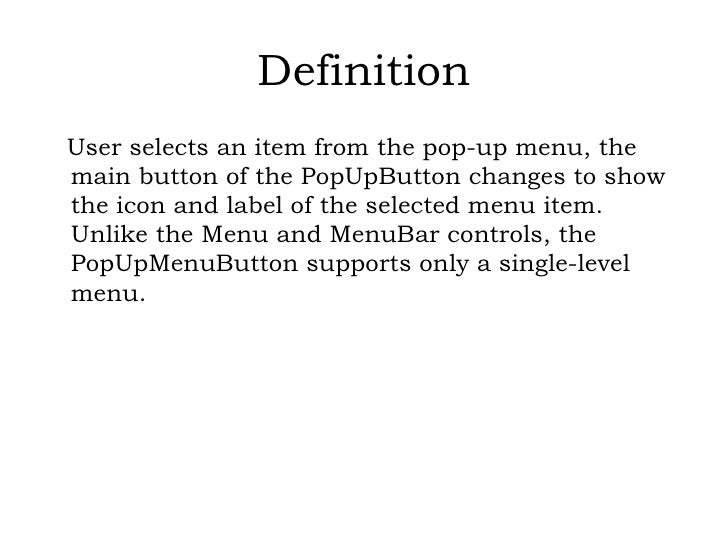
- Menu Bar Controls
- Where Is The Menu Bar Located
I create my own User Control with C#.Net DevExpress. Now i can use this Control in all my projects, but i need to use it in a DexExpress.XtraBars.Bar. How can i take this? I just can use the barit.
Hi! I'm trying to add buttons and menu to the 'Worksheet Menu Bar'. I want the buttons to appear first, and menu last, as it is there to contain the least relevant buttons. When I run the code, everything is perfect. After I restart excel, the menu gets shown before the buttons. Any ideas how to fix this? The code is simplified a little bit, with no error checking, removal of the previously existing buttons etc, to keep it as readable as possible, but I tested this version and it works and also shows the undesired behavior.
Make a bar plot.



The bars are positioned at x with the given alignment. Theirdimensions are given by height and width. The vertical baselineis bottom (default 0).
- Is an interactive Zoom. We are going to all join and ask all the questions you want. Ask to join me!!
- Found atop nearly every desktop window in Windows 10, the title bar usually lists the program name and the file or folder it’s currently displaying. For example, the figures show the title bars from the Windows WordPad and Notepad programs. The WordPad title bar lists the file’s name as Document because you haven’t had a.
Many parameters can take either a single value applying to all barsor a sequence of values, one for each bar.

| Parameters: | - xfloat or array-like
The x coordinates of the bars. Internet download manager free alternative. See also align for thealignment of the bars to the coordinates. - heightfloat or array-like
The height(s) of the bars. 3 minute game show camp rock. - widthfloat or array-like, default: 0.8
The width(s) of the bars. - bottomfloat or array-like, default: 0
The y coordinate(s) of the bars bases. - align{'center', 'edge'}, default: 'center'
Alignment of the bars to the x coordinates: - 'center': Center the base on the x positions.
- 'edge': Align the left edges of the bars with the x positions.
To align the bars on the right edge pass a negative width andalign='edge'.
|
|---|
| Returns: | BarContainerContainer with all the bars and optionally errorbars.
|
|---|
| Other Parameters: | - colorcolor or list of color, optional
The colors of the bar faces. Upload iphoto to dropbox. - edgecolorcolor or list of color, optional
The colors of the bar edges. - linewidthfloat or array-like, optional
Width of the bar edge(s). If 0, don't draw edges. - tick_labelstr or list of str, optional
The tick labels of the bars.Default: None (Use default numeric labels.) - xerr, yerrfloat or array-like of shape(N,) or shape(2, N), optional
If not None, add horizontal / vertical errorbars to the bar tips.The values are +/- sizes relative to the data: - scalar: symmetric +/- values for all bars
- shape(N,): symmetric +/- values for each bar
- shape(2, N): Separate - and + values for each bar. First rowcontains the lower errors, the second row contains the uppererrors.
- None: No errorbar. (Default)
See Different ways of specifying error barsfor an example on the usage of xerr and yerr. - ecolorcolor or list of color, default: 'black'
The line color of the errorbars. - capsizefloat, default:
rcParams['errorbar.capsize'] (default: 0.0) The length of the error bar caps in points. - error_kwdict, optional
Dictionary of kwargs to be passed to the errorbarmethod. Values of ecolor or capsize defined here takeprecedence over the independent kwargs. - logbool, default: False
If True, set the y-axis to be log scale. - **kwargs
Rectangle properties | Property | Description |
|---|
agg_filter | a filter function, which takes a (m, n, 3) float array and a dpi value, and returns a (m, n, 3) array | alpha | scalar or None | animated | bool | antialiased or aa | unknown | capstyle | CapStyle or {'butt', 'projecting', 'round'} | clip_box | Bbox | clip_on | bool | clip_path | Patch or (Path, Transform) or None | color | color | contains | unknown | edgecolor or ec | color or None or 'auto' | facecolor or fc | color or None | figure | Figure | fill | bool | gid | str | hatch | {'/', ', '|', '-', '+', 'x', 'o', 'O', '.', '*'} | in_layout | bool | joinstyle | JoinStyle or {'miter', 'round', 'bevel'} | label | object | linestyle or ls | {'-', '--', '-.', ':', ', (offset, on-off-seq), ..} | linewidth or lw | float or None | path_effects | AbstractPathEffect | picker | None or bool or float or callable | rasterized | bool | sketch_params | (scale: float, length: float, randomness: float) | snap | bool or None | transform | Transform | url | str | visible | bool | zorder | float |
|
|---|
Notes

Stacked bars can be achieved by passing individual bottom values perbar. See Stacked bar chart.
Note
In addition to the above described arguments, this function can takea data keyword argument. If such a data argument is given,every other argument can also be string s, which isinterpreted as data[s] (unless this raises an exception).
Objects passed as data must support item access (data[s]) andmembership test (sindata).






